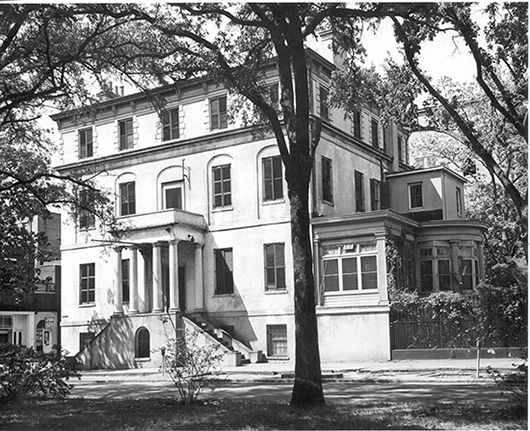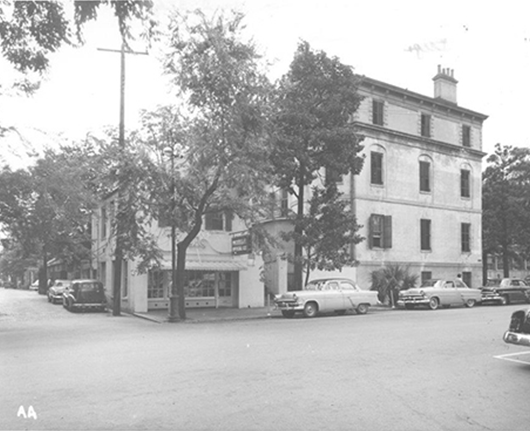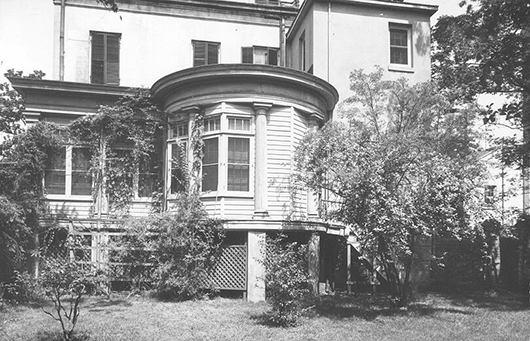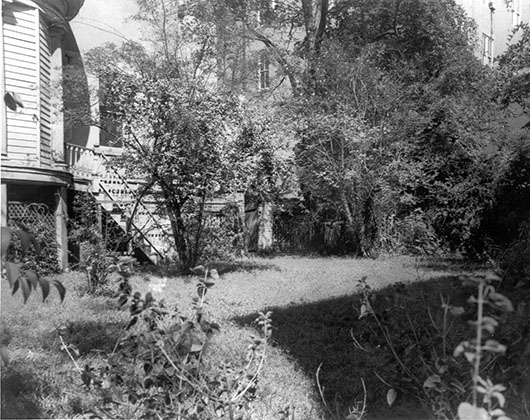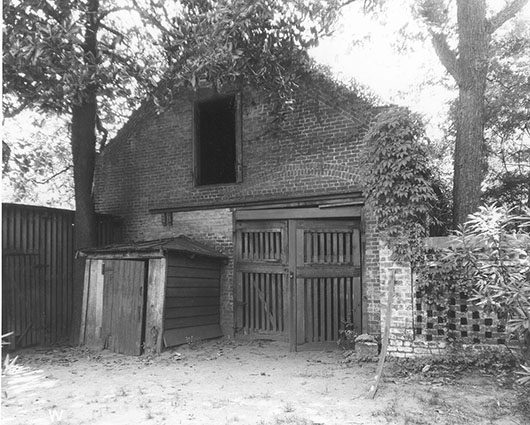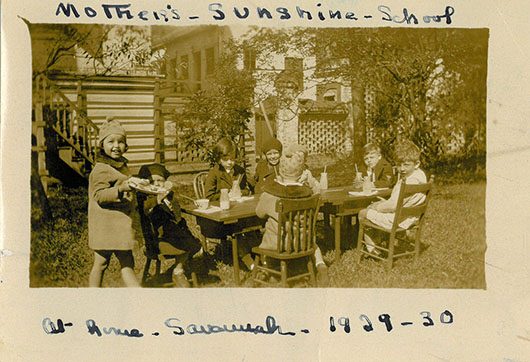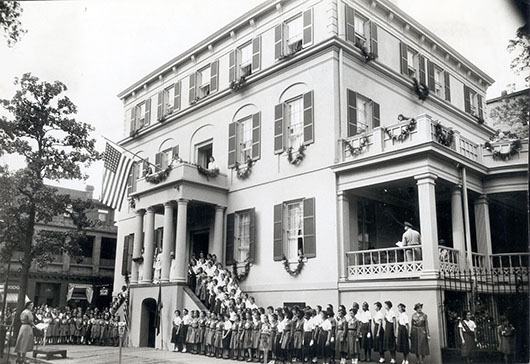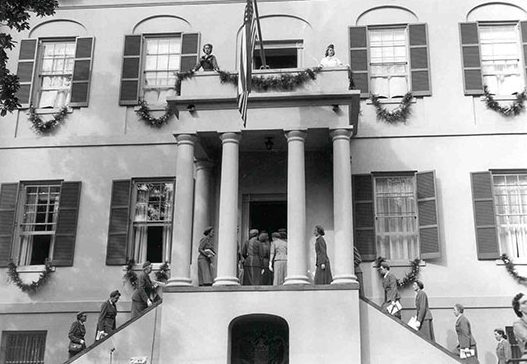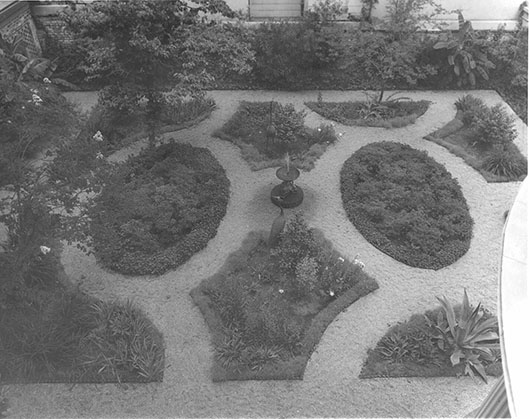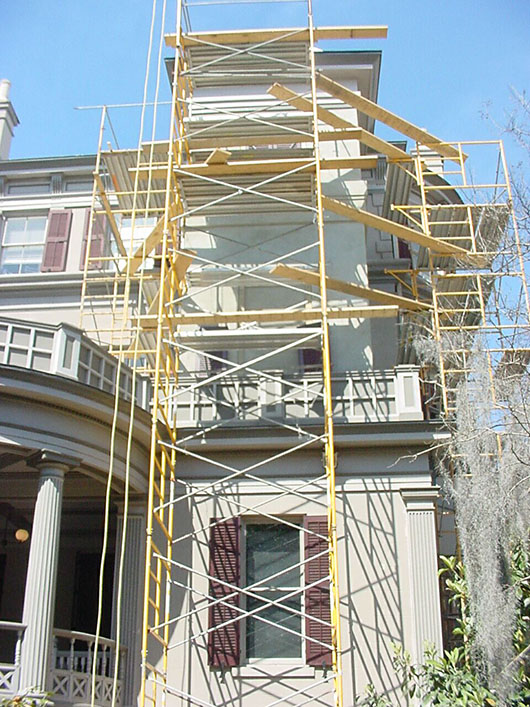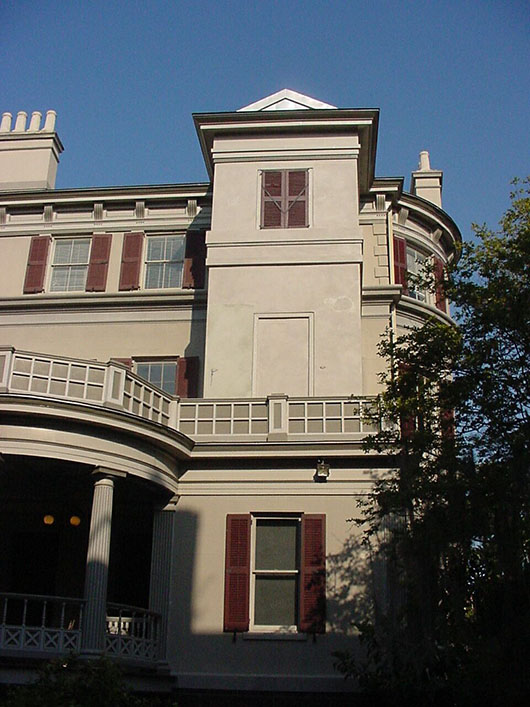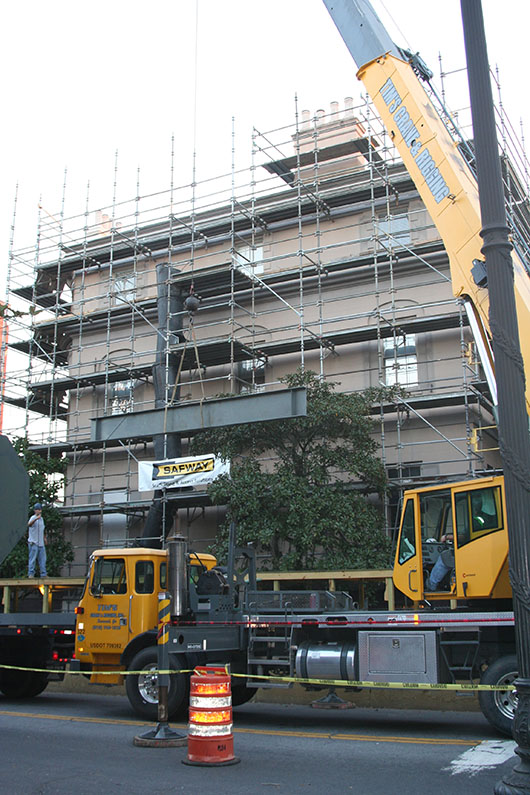
About the House
The Juliette Gordon Low Birthplace is primarily a Federal-style home built of brick covered with stucco. Elizabeth and James Moore Wayne had the house built in 1821 at the corner of Bull and South Broad (Oglethorpe Avenue today) and one of the prime intersections in Savannah. James, a lawyer and judge, eventually served as a Justice of the United States Supreme Court.
In 1831, William and Sarah Gordon, Juliette’s grandparents, bought the house. William died young, but Sarah lived in the house until her death in 1882. On October 31, 1860, Juliette (Daisy) was born in the house and remained here together with her mother, sisters, grandmother, and enslaved servants during the Civil War until Savannah was occupied by Union forces in December 1864.
Its role as the family seat continued when Daisy’s father bought the house after his mother’s death. Daisy’s family had deep connections to the house and lived close by. As children, she and her cousins played together there regularly and the newly renovated house was the center of Daisy’s marriage activities.
In March 1912, Daisy made the famous phone call to her cousin Nina Pape announcing the founding of the Girl Guides in America (changed to Girl Scouts in 1913). Girl Scouts of the USA (GSUSA) bought the house in 1953 and began its stewardship of the property. A significant financial investment was needed to restore the house and outbuildings for use by Girl Scouts. Over the ensuing six decades, GSUSA has continued to responsibly preserve and restore the nearly 200-year-old building, garnering preservation awards for its efforts.
Preservation Timeline
Historic Preservation at the Juliette Gordon Low Birthplace
Girl Scouts of the USA has been a dedicated steward of the Juliette Gordon Low Birthplace for decades, beginning with the 1953 decision to purchase its founder’s former home. The site was purchased from Eleanor Wayne Macpherson and other extended family members who owned shares in the estate. Girl Scouts of the USA advanced $65,000 from its capital fund to buy the house, but nearly three times the purchase price was needed to restore the property. A fundraising campaign, announced in the April 1954 edition of The Girl Scout Leader magazine, encouraged girls and councils to help fund the restoration. A national goal of $500,000 was set to pay for the cost of purchase, restoration, upkeep, and running of the birthplace.
In 1955, Dorothy Stratton, National Executive Director of Girl Scouts of the USA, explained the reasoning behind the purchase of the Juliette Gordon Low Birthplace—
Although the house itself is interesting as an example of Regency architecture, it is not primarily for its historic interest that Girl Scouts has bought it. Generally speaking, it is not within our purview to own or restore old houses. But this house is different. We are interested in restoring it in order to help the citizens of our country, and particularly present and future Girl Scouts, catch a bit of the fire and spirit and determination of the young girl who began life within its walls and whose character was largely formed during her life there.
Nice as it is to own this house and restore it to its former beauty, it is not to be a period piece unrelated to the life of Girl Scouts in the second half of the twentieth century. Mrs. Low was a woman of action. If we merely preserved her home, we would fail to realize completely the possibilities of her birthplace. To be true to her ideas and her plan for the girls of the United States, the birthplace must provide opportunities for girls to talk about their dreams, their ambitions, ways of serving their country, ways of making friends in their school, their town, their country, and other countries.
For over 70 years, Girl Scouts has stewarded the Juliette Gordon Low Birthplace, striving to find the balance between preservation and accessibility for the thousands who visit each year. Although historic preservation is not Girl Scouts’ mission, it has nonetheless been at the forefront of all decisions made in the care and management of the birthplace. As early as 1965, the National Park Service recognized the significance of the site by listing it on the National Register. In 2007, the Juliette Gordon Low Birthplace, the Andrew Low House, and the Girl Scout First Headquarters were made a National Historic Landmark District, the highest category of historic resources recognized by the Department of the Interior. Other accolades have followed, including a 2015 Georgia Trust for Historic Preservation Award for Excellence in Restoration.
The Juliette Gordon Low Birthplace is an urban site consisting of several buildings on two lots in the middle of downtown Savannah, Georgia. The house and outbuilding directly behind were completed by 1821. By 1953, the house was in disrepair, having been divided into apartments in the 1940s. The outbuilding was modified for commercial use in the 1930s with a large window fronting Bull Street, and was leased to Hodge Optical downstairs and another small business upstairs.
Two apartments occupied each floor of the main house except the basement and top floor, which remained empty. The side porch, or piazza, was enclosed as a bedroom, and on the upper floor a small kitchen projected out from the building’s façade.
In the 1930s, a nursery school operated in the main house and children played in the grass yard. By 1953, the yard was largely overgrown. The brick carriage house, built at the turn of the century, had not been used in decades and was structurally unsound.
To raise funds, a national campaign was administered by a special Birthplace Committee along with regional council administrators, and a grassroots effort by the girls and their volunteer leaders all over the country and the world.
In October 1956, Girl Scouts traveled to Savannah to celebrate the opening of the Birthplace as a place where girls could come to be inspired by Daisy’s life and imagine how they could make the world a better place. In 1965, the Birthplace of Juliette Gordon Low was listed on the National Register of Historic Places.
In 1956, the yard was redesigned as a
formal garden by Clermont Lee, the first female landscape architect to
own her own business in Savannah. There was little documentation of
any of the Gordon gardens and it is unknown how the side yard was used
by the family. Lee chose to design the space to look like a Victorian
parterre garden with planted islands edged with clay tiles. She
planned for this formal garden to be seen– not used– and designed it
to be viewed from outside the Oglethorpe Avenue fence or from the
piazza. Documents show a growing tension between Lee’s vision for a
formal garden and how visiting Girl Scouts used and experienced the
garden daily.
In 2000, a strategic planning session identified ten restoration projects needed to enable the site to more effectively serve girls. Included in this list was the renovation of program rooms, stabilization and repair of the central staircase, and renovation of the ground floor of the main house for a ticketing area, shop area, and program space for girls.
Remarkably, eight out of ten projects were completed by 2006. A new design for the garden, approved by the Birthplace Advisory Group, was about to be implemented, when serious structural defects were discovered in the framing of the top floor of the house. The garden was delayed while these concerns were investigated.
Continuing their long history of working to make the site accessible, Girl Scouts found a way to add an elevator to the building without sacrificing its historic integrity. The Birthplace is the only accessible historic house museum in Savannah and was recognized with a preservation award from the Historic Savannah Foundation in 2004 for the elevator project.
Despite the previous efforts, the building’s exterior continued to crack, allowing water to enter into the structure. In 2007, Girl Scouts enlisted the aid of Preservation Engineers to evaluate the structural soundness of the building and identify any repairs needed. A team of specialists assessed the conditions and causes before a series of repairs were designed. The wood framing of the building was analyzed and reinforced where needed and in 2009, staff were able to move into new offices on the top floor.
Beginning in 2012 and requiring two years, a comprehensive
restoration of the exterior treated every area through which water
could enter. Costing about $2.5 million, it included a new roof,
cornice, brownstone steps, window repair, and removal of the 1964
stucco to enable extensive replacement of fractured bricks which
caused exterior cracking. During a banner weekend in March 2012,
Birthplace staff accommodated record numbers of Girl Scouts
celebrating the 100th anniversary of Girl Scouting. On the following
Monday, March 12, scaffolding went up for the restoration work.
Despite the noise, dust and ever-present construction workers, the
Birthplace served over 80,000 visitors in 2012. GSUSA’s commitment
to excellence resulted in a beautiful outcome recognized by
preservation awards from the Historic Savannah Foundation, the Georgia
Trust of Historic Preservation, and the American
Institute of Architects in Savannah. In 2020, a modern building
was constructed to connect the east and west outbuildings and to
increase accessibility.
Historic preservation is never-ending. It requires thoughtful, deliberative investigation before projects begin. For 70 years, GSUSA has sought out knowledgeable experts in their fields to study, report, and recommend the best approaches to preserve and protect its historic structures. Our work to preserve the tremendous history of Juliette Gordon Low and the Girl Scouts continues.
